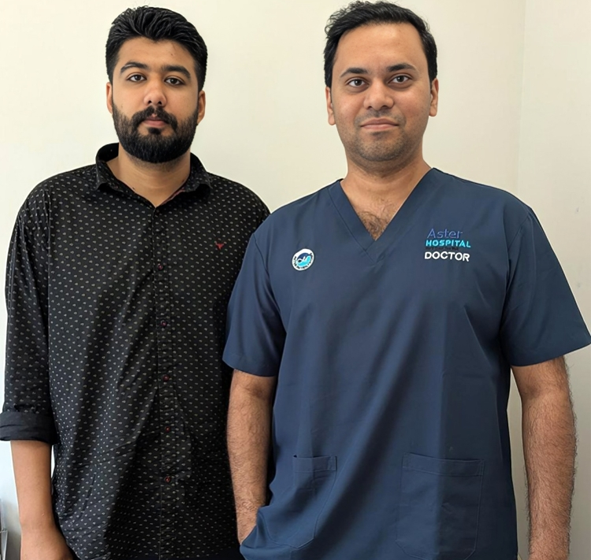Ajmal Perfumes Reaches 70-Store Milestone in the UAE with Latest Store launch
27-Year-Old Dubai Resident Successfully Treated for Rare Vein Condition at Aster Hospital Mankhool

Advanced minimally invasive procedure restores normal blood flow in rare case of Superior Vena Cava Syndrome (SVCS), ending a four-year health struggle for the young Dubai resident.
The majority of SVCS cases around 60–70% are associated with cancers such as lung cancer or lymphoma, while 30–40% result from long-term use of medical devices like central venous catheters or pacemakers, which can damage vessel walls and lead to narrowing.12
A smaller percentage, around 3–5% are linked to genetic clotting disorders. In very rare cases, the condition has no identifiable underlying cause, as seen in Muhammad Bilal’s case.
Dubai, UAE – August 4, 2025
In a landmark medical achievement, Aster Hospital, Mankhool, ranked No. 4 on Newsweek’s World’s Best Hospitals in the UAE list for 2025, successfully treated a young Dubai resident diagnosed with Superior Vena Cava Syndrome (SVCS), a rare and potentially life-threatening vein condition that blocks blood flow from the upper body back to the heart.
Muhammad Bilal, a 27-year-old Pakistani national, had been suffering from symptoms of SVCS since 2020. His condition began with swelling on the right side of his face and neck, which gradually spread to involve his eye and the entire face, along with the appearance of a swollen vein over his abdominal area. In addition, he experienced shortness of breath, severe headaches, and visibly enlarged veins across his neck, chest, and abdomen. Initially painless, the swelling eventually became painful and distressing. Despite multiple consultations at various hospitals in the UAE and his home country, his condition remained undiagnosed and untreated until he visited Aster Cedar Hospital and was referred to Dr. Roshan Rodney S, Specialist Vascular and Endovascular Surgeon at Aster Hospital Mankhool.
Upon clinical assessment and imaging scans, doctors confirmed a complete blockage in the superior vena cava—a major vein that carries blood from the upper body back to the heart. As a result, the body had started forming alternate blood flow channels to bypass the obstruction.
To treat the blockage, Dr. Roshan and his team opted for a minimally invasive vein procedure, which is now the preferred treatment for SVCS due to its lower risk profile and rapid symptom relief. Using advanced imaging tools, they performed balloon angioplasty and placed a self-expanding stent to open the blocked vein and restore normal blood flow to the heart.
Speaking on the severity of the patient’s condition, the complexity of the procedure, and the positive outcome achieved through a coordinated team effort, Dr. Roshan Rodney S, Specialist Vascular and Endovascular Surgeon at Aster Hospital Mankhool, said, “The vein was completely blocked, and the body had formed alternate routes to keep blood flowing. With the support of our anesthesia, cardiology, and ICU teams, we were able to restore blood flow seamlessly. The patient began to show significant symptom relief within hours of the procedure.”
The results were immediate and remarkable. By the following day, the swelling in Muhammad Bilal’s face had significantly reduced, and the prominent veins on his neck and abdomen had disappeared. He is now recovering well, with follow-up scans confirming the stent is working properly and his condition continues to improve.
Muhammad Bilal expressed his gratitude, saying, “I had been suffering for years, trying different hospitals and doctors, but no one could identify the problem. At Aster Hospital, I finally found answers. Dr. Roshan immediately diagnosed my condition and provided the treatment I had been waiting for. The swelling is gone, the pain has stopped, and I feel like I can live normally again. The care I received from the doctors, nurses, and staff made me feel like I was with family. I’m so thankful to be able to return to my regular life.”
This case shines a light on the growing use of endovascular stenting in treating rare vein conditions and highlights the value of early diagnosis, modern imaging, and teamwork in managing complex health issues.
SVCS is most commonly caused by cancers such as lung cancer or lymphoma, which can press on or grow into the vein, this happens in about 70% of cases[1]. In around 30% of cases, it’s linked to long-term use of medical devices like central venous catheters or pacemakers, which can damage the vein walls over time.[2] A small number of cases (about 3–5%) are related to genetic clotting disorders, where repeated blood clots cause scarring and narrowing of the vein. [3] In extremely rare cases, such as Muhammad Bilal’s, the cause remains unknown and is called idiopathic SVCS.
For patients and families grappling with unexplained vein-related conditions, this successful case offers hope, showing how timely diagnosis and the right treatment can truly change lives
This milestone reflects Aster Hospital Mankhool’s dedication to pioneering care and improving patient outcomes through timely diagnosis and minimally invasive interventions.
[1] https://www.jto.org/article/S1556-0864(23)00523-3/fulltext

















